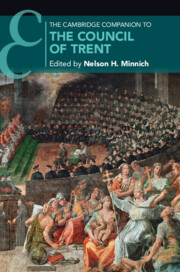Book contents
- The Cambridge Companion to the Council of Trent
- Frontispiece
- Cambridge Companions to Religion
- The Cambridge Companion to the Council of Trent
- Copyright page
- Contents
- Figures
- Contributors
- Acknowledgments
- Abbreviations
- 1 Introduction
- 2 The Organizational Structure of the Council of Trent
- 3 Schools of Theology at the Council of Trent
- 4 Scripture and Traditions at the Council of Trent
- 5 Original Sin and Justification
- 6 Sacraments in General, Baptism and Confirmation
- 7 The Sacrament of Penance at the Council
- 8 Presence and Sacrifice
- 9 Bishops
- 10 The Tridentine Proposal for the Formation of the Clergy
- 11 Pastoral Care
- 12 The Decree on Marriage
- 13 Reform of the Religious Orders
- 14 Sacred Art
- 15 Sacred Music
- 16 The Papacy and the Application of Conciliar Decrees
- Index
- Cambridge Companions to Religion (continued from page iii)
- References
10 - The Tridentine Proposal for the Formation of the Clergy
The Seminaries
Published online by Cambridge University Press: 02 October 2023
- The Cambridge Companion to the Council of Trent
- Frontispiece
- Cambridge Companions to Religion
- The Cambridge Companion to the Council of Trent
- Copyright page
- Contents
- Figures
- Contributors
- Acknowledgments
- Abbreviations
- 1 Introduction
- 2 The Organizational Structure of the Council of Trent
- 3 Schools of Theology at the Council of Trent
- 4 Scripture and Traditions at the Council of Trent
- 5 Original Sin and Justification
- 6 Sacraments in General, Baptism and Confirmation
- 7 The Sacrament of Penance at the Council
- 8 Presence and Sacrifice
- 9 Bishops
- 10 The Tridentine Proposal for the Formation of the Clergy
- 11 Pastoral Care
- 12 The Decree on Marriage
- 13 Reform of the Religious Orders
- 14 Sacred Art
- 15 Sacred Music
- 16 The Papacy and the Application of Conciliar Decrees
- Index
- Cambridge Companions to Religion (continued from page iii)
- References
Summary
On July 15, 1563, the bishops gathered in Trent unanimously approved the decree Cum adolescentium aetas that recommended the erection of a seminary in each diocese. It was a provision of epochal significance that endowed the Church with an instrument for the care of vocations to the ordained priesthood, according to the pastoral ideal of cura animarum. For the first time, referring to previous experiences and responding to the challenges raised by Protestants, a council laid the foundations for the creation of a specific educational institution for the spiritual, intellectual, and human preparation of its pastors. The Tridentine decree on priestly formation influenced, according to different rhythms, all the territories of the Roman Church. In many dioceses the institution took off only after decades (centuries, in some cases) of unsuccessful attempts, but certainly the decree of the twenty-third session had suggested a stable and uniform model of ecclesiastical formation, partly perfectible and adaptable, but now essential.
- Type
- Chapter
- Information
- The Cambridge Companion to the Council of Trent , pp. 209 - 224Publisher: Cambridge University PressPrint publication year: 2023



